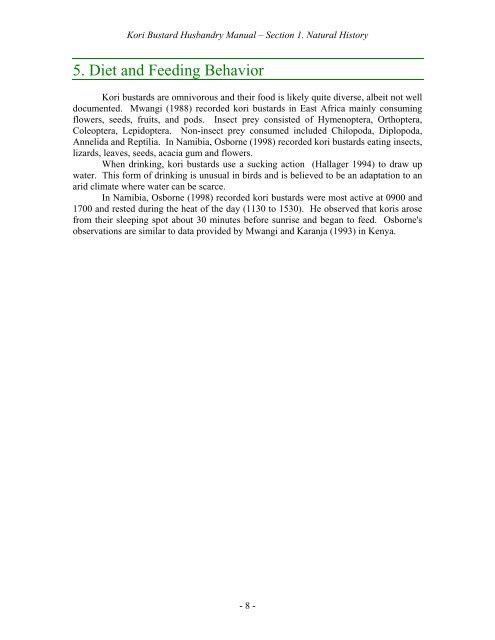Kori Bustard Husbandry Manual - Gruiformes
Kori Bustard Husbandry Manual - Gruiformes
Kori Bustard Husbandry Manual - Gruiformes
Create successful ePaper yourself
Turn your PDF publications into a flip-book with our unique Google optimized e-Paper software.
<strong>Kori</strong> <strong>Bustard</strong> <strong>Husbandry</strong> <strong>Manual</strong> – Section 1. Natural History<br />
5. Diet and Feeding Behavior<br />
<strong>Kori</strong> bustards are omnivorous and their food is likely quite diverse, albeit not well<br />
documented. Mwangi (1988) recorded kori bustards in East Africa mainly consuming<br />
flowers, seeds, fruits, and pods. Insect prey consisted of Hymenoptera, Orthoptera,<br />
Coleoptera, Lepidoptera. Non-insect prey consumed included Chilopoda, Diplopoda,<br />
Annelida and Reptilia. In Namibia, Osborne (1998) recorded kori bustards eating insects,<br />
lizards, leaves, seeds, acacia gum and flowers.<br />
When drinking, kori bustards use a sucking action (Hallager 1994) to draw up<br />
water. This form of drinking is unusual in birds and is believed to be an adaptation to an<br />
arid climate where water can be scarce.<br />
In Namibia, Osborne (1998) recorded kori bustards were most active at 0900 and<br />
1700 and rested during the heat of the day (1130 to 1530). He observed that koris arose<br />
from their sleeping spot about 30 minutes before sunrise and began to feed. Osborne's<br />
observations are similar to data provided by Mwangi and Karanja (1993) in Kenya.<br />
- 8 -


